At around $410 retail, the Intel Xeon Silver 4108 is one of the more intriguing values for low power servers. It is the lowest-cost eight core Intel Xeon Scalable processor available with Hyper-Threading (16 threads.) It also holds the title of being the lowest cost CPU in the Intel Xeon Scalable processor range with Turbo boost. With the Intel Xeon Silver 4108 there is a major step up in performance from the Intel Xeon Bronze series. As you will see in this piece, the additional features are why we recommend it for single socket systems over all but the most cost conservative servers that go for Bronze.
In this review, we are going to take the perspective of a buyer looking for a single socket solution. We are going to compare these results to other Xeon Silver and Bronze CPUs so one can see what an incremental increase or decrease in cost will net in terms of performance. We will also compare to other single socket solutions such as the Xeon D series and Intel Xeon E3 series.
For those looking for comparable AMD EPYC numbers, we are as frustrated as you are. We have two AMD EPYC 7251’s and two AMD EPYC 7281’s that will compete in the Xeon Silver range (and at least one of every other EPYC SKU for that matter) but the deliveries of our single socket review systems have been perpetually delayed. We expect that we will have more data on this in the next two weeks. Stay tuned to STH for those comparisons. At the same time, the street pricing for the AMD EPYC 7251 is around $510 at this point or about 25% more than the Silver 4108 so perhaps a comparison with the Intel Xeon Silver 4110 would be more appropriate there.
Key stats for the Intel Xeon Silver 4108: 8 cores / 16 threads, 1.8GHz base and 3.0GHz turbo with 11MB L3 cache. The CPU features a 85W TDP. Here is the ARK page with the feature set.
Test Configuration
Here is our basic test configuration for single socket Xeon Scalable systems:
- Motherboard: Supermicro X11SPH-nCTF
- CPU: Intel Xeon Silver 4108
- RAM: 6x 16GB DDR4-2400 RDIMMs (Micron)
- SSD: Intel DC S3710 400GB
- SATADOM: Supermicro 32GB SATADOM
One of the key advantages the Intel Xeon Silver series has is the ability to use up to 12 DIMMs per socket. Intel’s embedded platforms and quad core Intel Xeon E3-1200 V6 series platforms cannot do this in 2017. DDR4-2400 is the fastest memory supported on the Xeon Silver platform which is why we are not using faster speeds.
Single Intel Xeon Silver 4108 Benchmarks
For this exercise, we are using our legacy Linux-Bench scripts which help us see cross platform “least common denominator” results. We do have a full set of expanded benchmarks from our next-gen test suite (Linux-Bench2) so expect to see those results sprinkled in as we get a larger comparison data set built. These results have also been previewed elsewhere, such as the Intel Atom C3955 benchmarks we did so you can see larger data sets in our other reviews. Here we are going to focus on generational performance.
Python Linux 4.4.2 Kernel Compile Benchmark
This is one of the most requested benchmarks for STH over the past few years. The task was simple, we have a standard configuration file, the Linux 4.4.2 kernel from kernel.org, and make the standard auto-generated configuration utilizing every thread in the system. We are expressing results in terms of compiles per hour to make the results easier to read.
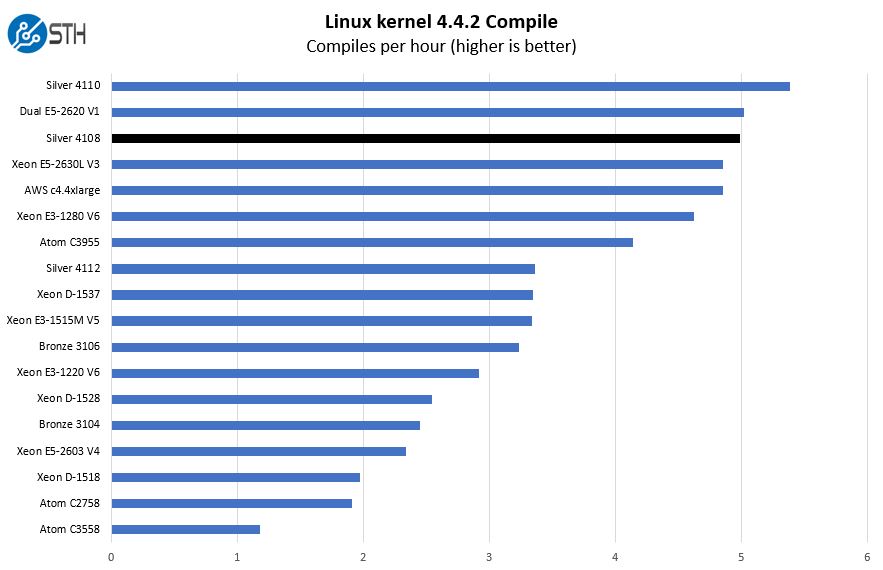
For us, the Linux kernel compile benchmark scales well over many cores and across architectures. We added a few extra comparison points into this piece as we wanted to show a comparison to an AWS c4.4xlarge instance, V1 and V3 Xeon E5 series parts, the newest and previous generation Atom CPUs, and the latest Intel Xeon E3-1280 V6 CPU.
There are however two comparisons we wanted to highlight. First, compared to the Intel Xeon Bronze 3106, the SKU immediately below the Silver 4108, for about $100 one gets about 54% more performance. In the context of a typical low-cost $2500 system, that is a 4% price increase for 54% more performance. Second, the dual Intel Xeon E5-2620 V1 comparison is intriguing. The Xeon E5-2620 occupies the same space in the stack that the Intel Xeon Silver 4108 does as the lowest hyper-threading and turbo enabled SKU of its generation. Five generations later and one can essentially replace two 95W (V1) CPUs with a single Xeon Silver.
c-ray 1.1 Performance
We have been using c-ray for our performance testing for years now. It is a ray tracing benchmark that is extremely popular to show differences in processors under multi-threaded workloads.
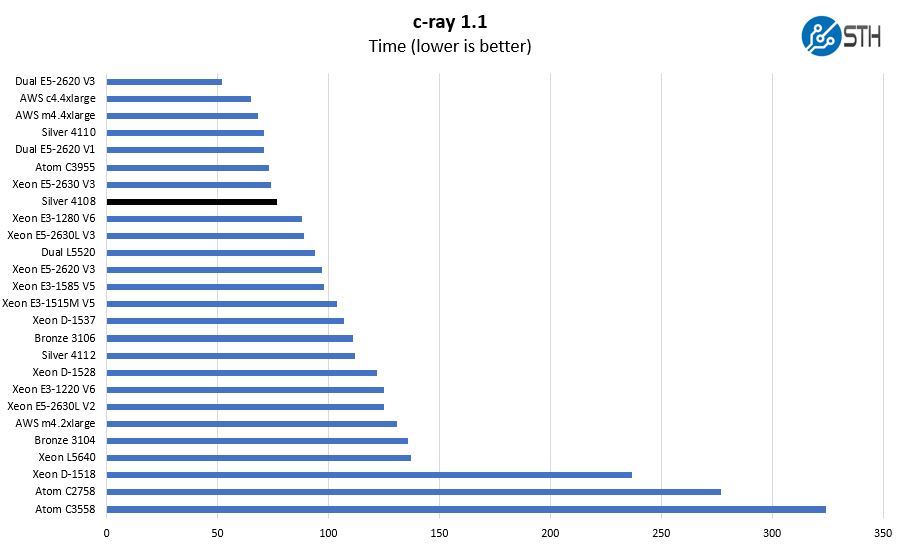
Here the Intel Xeon Silver 4108 is roughly on par with the Intel Xeon E5-2630 V3 which is two generations older at a 50% higher price point and with much higher clocks.
7-zip Compression Performance
7-zip is a widely used compression/ decompression program that works cross platform. We started using the program during our early days with Windows testing. It is now part of Linux-Bench.
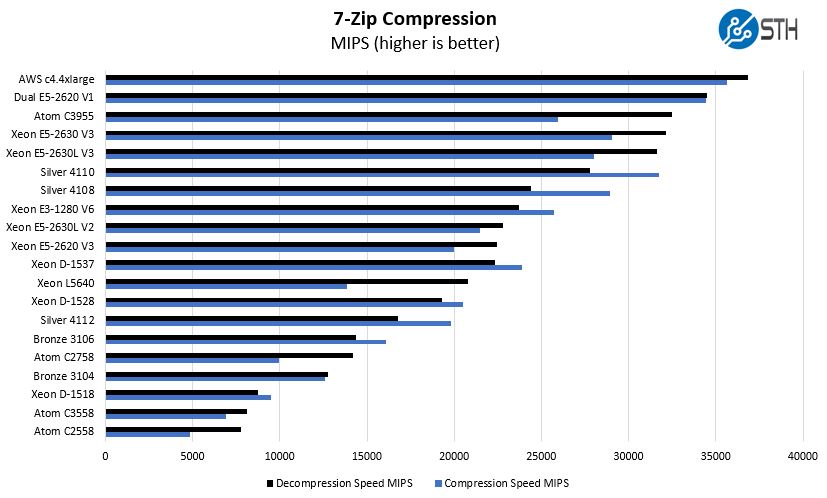
We sort this chart based on decompression speed. You can see that had we sorted by compression MIPS the Silver 4108 would have moved up two spots in the chart.
NAMD Performance
NAMD is a molecular modeling benchmark developed by the Theoretical and Computational Biophysics Group in the Beckman Institute for Advanced Science and Technology at the University of Illinois at Urbana-Champaign. More information on the benchmark can be found here. We are going to augment this with GROMACS in the next-generation Linux-Bench in the near future. With GROMACS we have been working hard to support Intel’s Skylake AVX-512 and AVX2 supporting AMD Zen architecture. Here are the comparison results for the legacy data set:
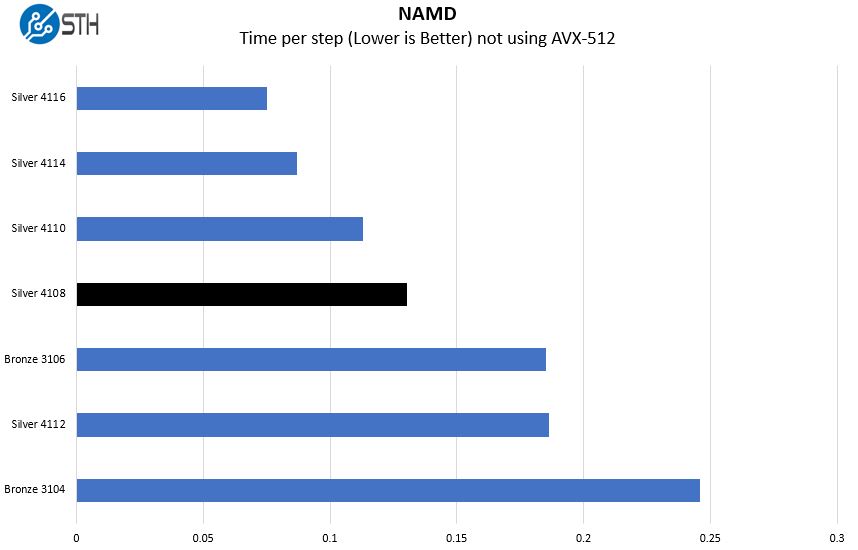
We are showing this view just to give an idea of the entire Bronze and Silver SKU stacks. One will notice better multi-threaded performance than the more expensive Xeon Silver 4112 and a significant jump ahead of the Bronze 3106.
Sysbench CPU test
Sysbench is another one of those widely used Linux benchmarks. We specifically are using the CPU test, not the OLTP test that we use for some storage testing.
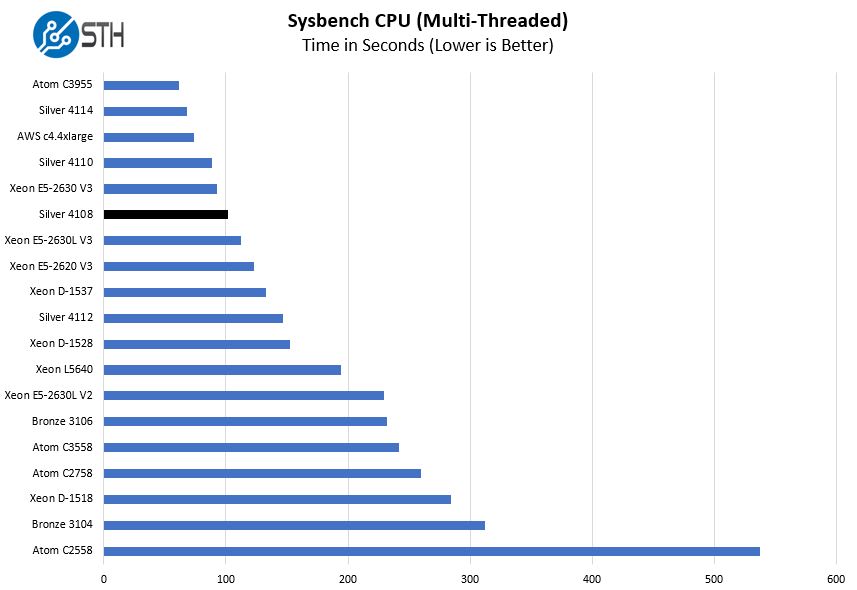
Here you can see the impact of the newer cores versus the Intel Xeon D-1537. While both are 8 core/ 16 thread parts, the newer cores and higher-speed Turbo help the Silver 4108 significantly. If you do not need the smaller footprint and lower power consumption, the Intel Xeon Silver 4108 single socket platform is extremely competitive.
OpenSSL Performance
OpenSSL is widely used to secure communications between servers. This is an important protocol in many server stacks. We first look at our sign tests:
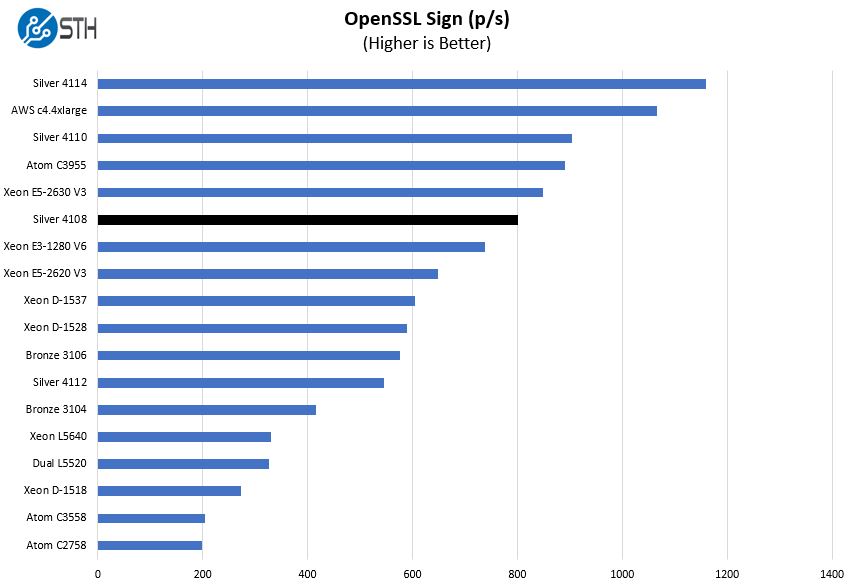
Here are the verify results:
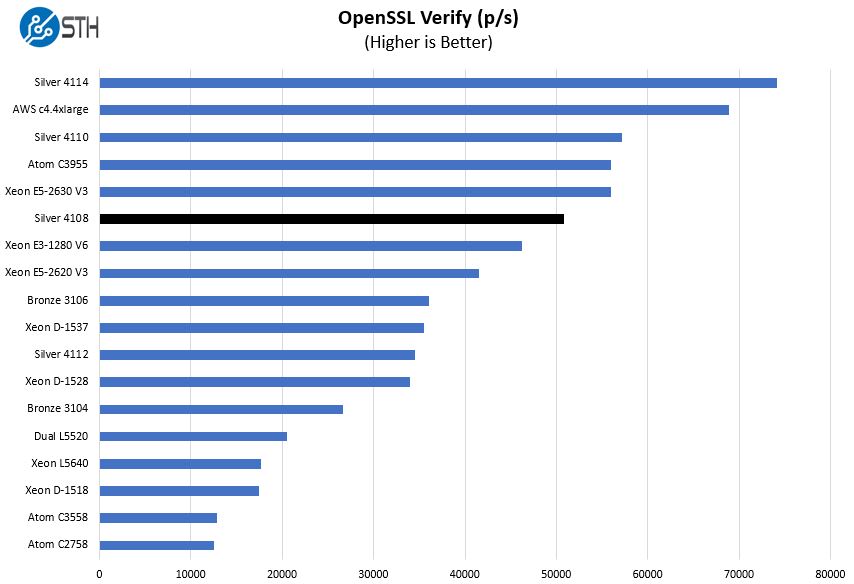
While the Intel Xeon E3-1280 V6 is the top-end SKU for the Kaby Lake Xeon E3 line, and around the same price as the Silver 4108, its four high-speed cores run out of steam against the low end of the bigger platform. If you are thinking Intel Xeon E3-1280 V6, the Silver line should be an intriguing alternative.
UnixBench Dhrystone 2 and Whetstone Benchmarks
One longest-running tests is the venerable UnixBench 5.1.3 Dhrystone 2 and Whetstone results. They are certainly aging, however, we constantly get requests for them, and many angry notes when we leave them out. UnixBench is widely used so we are including it in this data set. Here are the Dhrystone 2 results:
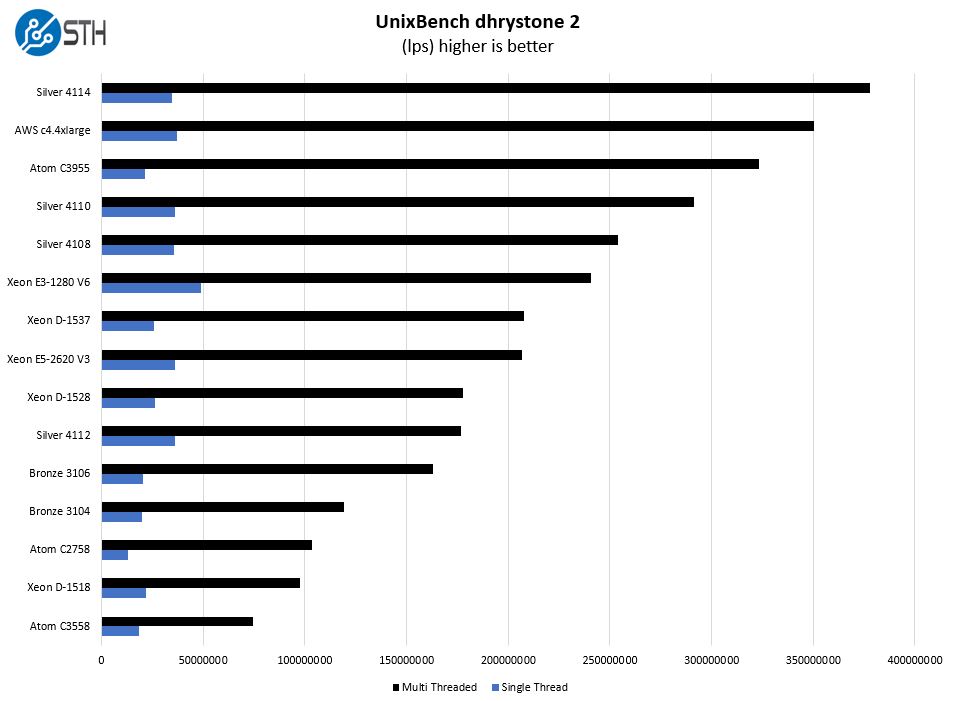
Here are the whetstone results:
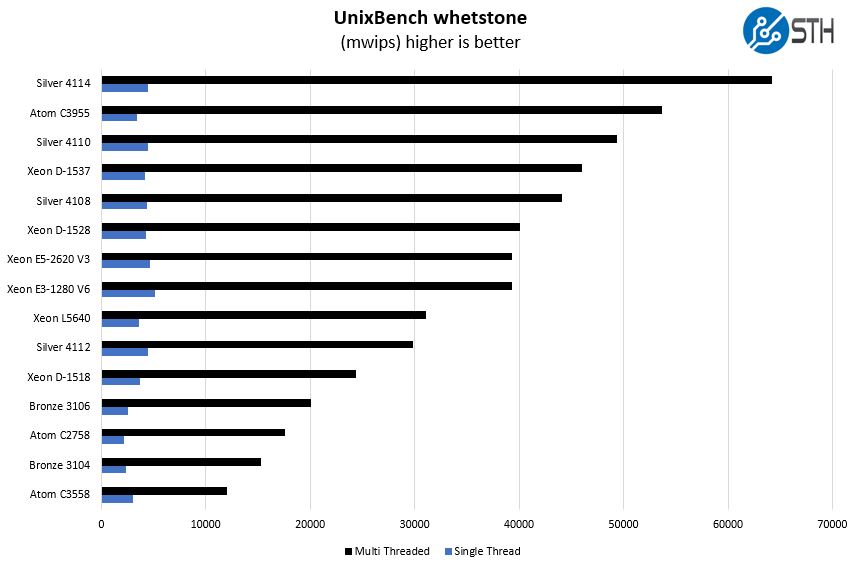
Overall these figures are in-line with what we would expect. We did want to point out that moving up from the Bronze 3106 to the Silver 4108 is a huge jump in performance. At the same time, single-threaded performance on the Xeon Silver line is going to be extremely similar because each SKU has a 3.0GHz maximum single core turbo boost speed.
GROMACS 57K Atom AVX2/ AVX-512 Enabled
We have a small GROMACS 57K Atom simulation we previewed in the first AMD EPYC 7601 Linux benchmarks piece. In Linux-Bench2 we are using an updated set that scales to 4-socket configurations with enough Atoms to fill all cores. For now, we do have a small dataset with the original work which remains valid, albeit we are going to transition to a larger set soon. This test will use the AVX-512 and AVX2 extensions if available.
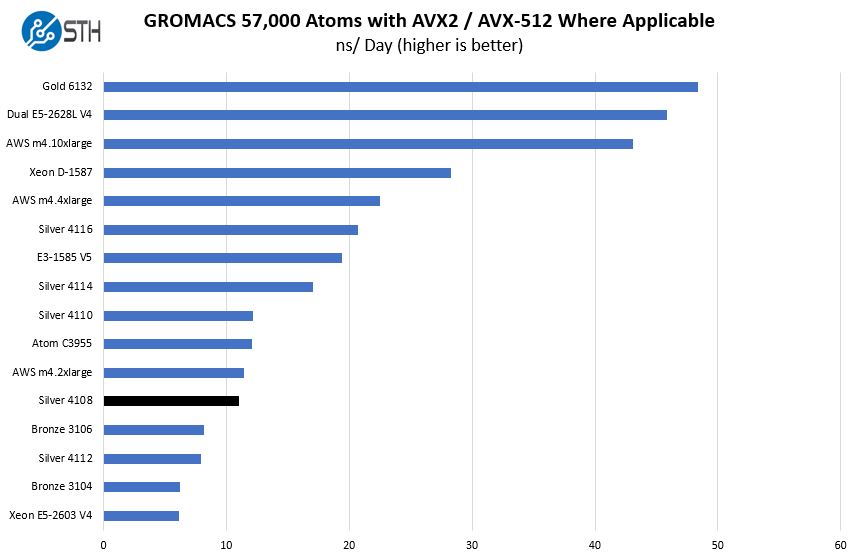
While the Silver 4108 suffers from low AVX-512 clock speeds, it does make some massive gains in terms of incremental improvement over the Bronze 3106. This is one case where ~30% more cost yields 33% (or more) improvement. At the same time, the Intel Xeon Gold 6132 result shows the power of having 75% more cores, dual AVX-512 execution and higher clocks in the same socket. It puts about 5x the performance for about 5x the cost in the same socket.
Intel Xeon Silver 4108 Power Consumption
We normally only publish power consumption data on full systems we review. There are too many variables for this data to land in a CPU test. At the same time, we wanted to highlight the Intel Xeon Silver 4108 which hit a maximum of around 93W measured at the outlet in our testing. While it may be an 85W TDP part, with 10Gbase-T links active, a SAS 3008 12gbps controller and a number of drives / DIMMs in the system. The Intel C622 PCH has a 17W TDP. If you subtract out some power consumption for the rest of the system, the Xeon Silver 4108 is absolutely sipping power. This chip borders on Intel Xeon D territory and below Intel Xeon E3-1200 V6 even with more memory installed.
Market Positioning
Unlike what we saw with the Intel Xeon Silver 4112 benchmarks and review, the Intel Xeon Silver 4108 has straightforward market positioning: it is the lowest cost Intel Xeon Silver SKU and offers a massive performance jump over the Intel Xeon Bronze series. While one may look at a $400 v $300 CPU and think the difference is $100 or 33% more when you look at overall system costs, that $100 is actually much smaller and likely more like 3-10%. We do think there is a lot of merit to bump budgets slightly and get the Intel Xeon Silver 4108 over the Intel Xeon Bronze 3106.
Final Words
If you are in the market for this range of performance, there are a few considerations. If you need ultra low power, the Atom C3000 and Xeon D series both provide lower power. At the same time, both sacrifice features such as RAM capacity and bandwidth as well as overall platform capabilities. The higher-end of the Intel Xeon E3-1200 V6 line is going to be a tough sell for any application that can utilize more cores and at least an ATX form factor. If you have historically been a buyer of the Intel Xeon E5-2620 V4 series, then this is your direct replacement. Within the Xeon Scalable line, this is a major jump in performance over the Bronze 3106, however, there are SKUs such as the Silver 4110 and 4114 just above this that have similarly strong value propositions.

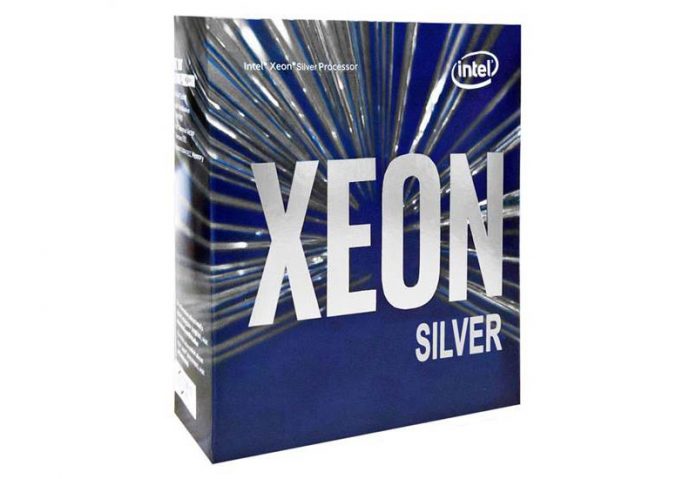



Hi
thanks again for the nice benchmarks. So avx 512 is really a mess, the xeon v3 e5 line has 4 cores no avx 512 only 2 ram channels and still smash all but one silber CPU, even xeon d does better. I would love to see some 2620v4 gromacs numbers.
E3-1585 V5 performance in GROMACS seems astonishingly good for a four core processor. Not only compared to Xeon SP, but also to EPYC: dual EPYC 7601 with a total of 64 cores achieved ~75 ns/day, while four cores of E3-1585 got almost 20 ns/day. So ns/day/core was about four times as high! Or is the test case so small that scaling beyond four cores isn’t good?
Anon and Tobias – those are excellent observations. As noted, the 57K Atom model is being depreciated. On the Intel Xeon E3-1585 V5 benchmark piece Cliff just published he published both the 57K model and our go-forward “STH Small” test case which scales considerably better with Skylake-SP. Still building the data set there but we have two dozen machines up right now to do just that.
@Tobias
The all core turbo drops from 2100 MHz (No AVX) to 1200 MHz (AVX512) with the Silver 4108.
So the theoretical 2x perf with the same clockspeed is nice when the clockspeed stays the same (which it doesn’t). AVX512 looks nice in theory but in the real world the clockspeed drops and/or the power usage goes up, upto 1,5 times the TDP.
Where the dual EPYC7601 system tops at only 480 Watt the quad XEON Platinum 8180 tops at a whopping 1336 Watt. TDP of EPYC is 180 Watt and the TDP of the XEON is 205. Doing the math:
System: Supermicro 2U Ultra EPYC Server (AS-2023US)
CPUs: 2x AMD EPYC 7601 32-core/ 64-thread CPUs
RAM: 256GB (16x16GB DDR4-2400 or 16x16GB DDR4-2666)
OS SSD: Intel DC S3710 400GB
OS: Ubuntu 17.04 “Zesty” Server 64-bit
NIC: Mellanox ConnectX-3 Pro 40GbE
CPU(s): 4x Intel Xeon Platinum 8180 28 core/ 56 thread CPUs (112 cores/ 224 threads total) with 2.5GHz base and 3.7GHz turbo clocks, 38.5MB L3 cache each
Platform: Intel S4PR1SY2B
RAM: 768GB in 24x SK.Hynix 32GB DDR4-2666 2RX4 DIMMs
OS SSD(s): 1x Intel DC S3700 400GB
OSes: Ubuntu 14.04 LTS, Ubuntu 17.04, CentOS 7.2
It seems that the XEON’s uses at least 100 Watt more per piece than the TDP, going from 3200 MHz (No AVX) to 2300 MHz (AVX512). 3200 x 1,5 ~ 2300 x 2. It looks like AVX512 is a lot of marketing.